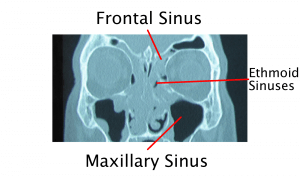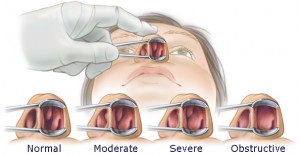What Are The Sinuses And What Is Sinusitis?
Sinuses are spaces in the skull that are lined with tissue (mucosa) that warms, humidifies and purifies the air that we breathe. The sinuses constantly make fluid that purifies the nose and prevents infection. Small openings in each sines will drain into the inside of the nose. There are four sinuses on each side including the maxillary sinuses in the cheeks, frontal sinuses in the forehead, ethmoid sinuses between the eyes, and sphenoid sinuses in the back of the nose.
Read our in-depth article about what the sinuses are.
What Are The Causes Of Sinusitis?
Causes of sinusitis include:
- The common cold
- Swelling of the lining of the nose
- Nasal polyps
- Deviated septum
What Are The Signs And Symptoms Of Sinusitis?
Thick drainage from the nose – Infected mucous is thicker and in larger amounts than normal, maybe green or yellow, can be foul smelling, and can drain from the nose or be coughed up.

A sinus infection can cause severe pain and discomfort, including headaches, toothaches and nasal congestion.
Headache or sinus pain – Pressure from blockage of the small sinus cavities can cause severe facial pain, headache, toothache and feeling of nasal congestion. When lying flat the congestion and pain are more extreme and can dramatically disrupt sleep. Changes in barometric pressure from flying or scuba diving should be avoided.
Repeated sinus infections – Tissue thickening inside the sinuses can narrow the passages and increase the risk of getting another infection. The bacteria inside the nose may become resistant to antibiotics making infections more difficult to treat.
These are only a few of the symptoms associated with sinusitis. Learn about additional signs and symptoms of a sinus infection.

Antibiotics are a common treatment method for sinus infections.
How Is Sinusitis Treated?
History and examination inside the nose will determine if a sinus infection is present. Successful treatment of an acute sinus infection is often possible using conservative and symptomatic treatment and letting the infection pass. Conservative treatment includes a combination of anti-allergy medication, decongestants, nasal sprays, saline rinses and environmental controls. When sinusitis fails to resolve, using an antibiotic directed toward the most likely causes of infection will usually work. Failure of the infection to clear may require an even longer course of antibiotics with steroids to control inflammation. Chronic sinusitis or many episodes of acute sinusitis during a year may require further testing including a sinus CT scan.
When Is Sinus Surgery Necessary?
When appropriate medical and environmental treatment has failed, sinus surgery can dramatically improve your quality of life and sense of well-being. Endoscopic sinus surgery is a procedure used to remove blockages in the sinuses to reopen the small passages needed for healthy sinus function.

CT scans and other computerized imaging technology helps doctors locate which sinus areas need treatment.
Over the past decade, the advancement of endoscopic sinus surgery using minimally invasive micro-surgical instruments to restore the natural drainage of the sinuses has resulted in more effective and better-tolerated sinus surgery.
Computed tomography (CT) scanning in the management of sinusitis has led to more precise localization of sinus problems. The doctor may also use 3-dimensional imaging during the procedure to provide an additional layer of safety and thoroughness. With Norelle Health’s advanced sinus techniques, placement of packing within the nose and the associated discomfort is rarely needed. This improves the overall experience and contributes to a more rapid recovery. Patients are typically back to normal activity in 7-10 days.
Sinus Surgery Preparation

Enlarged turbinates can cause severe congestion, trouble breathing and sinus pain.
A minimum of half an hour is needed to fully understand your expectations and to get a complete history and evaluation of the inside and outside of your nose. Knowing what to expect will make the entire experience more pleasant and increase your satisfaction with the surgical results. The doctor will discuss the cosmetic and functional expectations of your surgery in detail to make sure all of your questions are answered. Depending on whether you have functional/breathing issues insurance may cover part of your surgery.
What is Functional Endoscopic Sinus Surgery (FESS)?
Functional endoscopic sinus surgery (FESS) is an option for patients when other medical treatments have failed. The surgery seeks to restore normal function to the sinuses and limit recovery time. The surgery addresses each individual sinus and removes the blockages to allow each sinus to be ventilated and drain through its natural opening. Polyps and scar tissue are removed along with thickened mucosa to improve sinus function. All procedures are performed through the nostrils. Straightening a deviated nasal septum (septoplasty) or reducing enlarged turbinates (turbinoplasty) at the same time may improve the results of sinus surgery. Insurance will almost always cover the cost of sinus and breathing surgery.
How Is The Recovery From Sinus Surgery?

After recovery from sinus surgery, most patients quickly notice an incredible improvement in health and well-being.
Patients will usually be comfortable enough to go home an hour or two after the procedure. The doctor does not usually place packing in the nose as this can cause discomfort. For the first few days, a feeling of a “head-cold” is normal and this may resolve before the first office visit 1 week after the procedure. The nose is cleaned at the follow-up visit and most patients are able to go about their normal activities. An improvement in ease of breathing and a decrease or complete elimination in the frequency and severity of sinus infections is common.
Can Sinus And Breathing Surgery Be Combined With Rhinoplasty (Nose Job)?
Yes. Because the recovery periods are the same, no additional time is needed. A form-fitting splint is often placed over the nose for the first week. Insurance may help with sinus and breathing care as well as with traumatic nose injuries, but will never pay for cosmetic surgery.